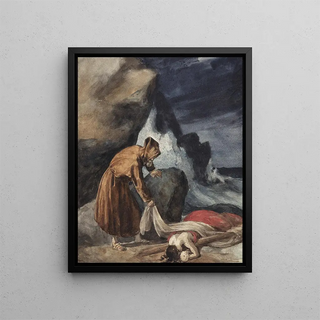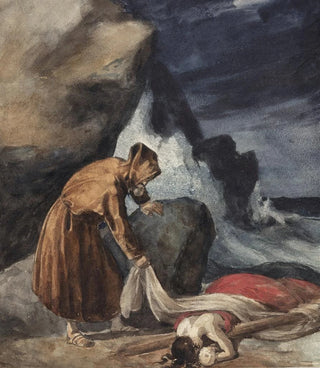Art print | The Storm - Théodore Géricault


View from behind

Frame (optional)
Reproduction La Tempête - Théodore Géricault – Captivating Introduction
In the fascinating panorama of art history, certain works stand out for their emotional power and their ability to capture the essence of the human experience. "La Tempête - Théodore Géricault" is a striking example. This iconic canvas, which evokes both struggle and resilience, immerses us in a tumultuous universe where nature runs wild. Géricault, through his creative genius, manages to convey an atmosphere of tension and anxiety, while revealing the sublime beauty of chaos. The scene, both dramatic and poetic, invites the viewer to question the forces that surpass us and our place in relation to them.
Style and uniqueness of the work
Géricault's work is characterized by a romantic style that transcends the conventions of his time. With "La Tempête," he uses dark colors and striking contrasts to create an atmosphere of urgency and despair. The human figures, tormented and expressive, struggle against the elements, symbolizing man's fight against the forces of nature. The dynamic movements of the characters, combined with tumultuous waves, give the composition an intense dramatic quality that captivates the eye. Géricault, by incorporating elements of realism, manages to bring this scene to life, making the experience almost tangible. Every brushstroke seems to vibrate with vital energy, inviting the viewer to feel the frenzy of the storm.
The artist and his influence
Théodore Géricault, an emblematic figure of the Romantic movement, marked his era with his boldness and innovative vision. His passion for painting and his commitment to representing human emotion made him a pioneer whose influence still endures today. Géricault, through works like "La Tempête," explored universal themes such as suffering, struggle, and beauty in despair. His daring approach inspired many artists, paving the way for a deeper exploration of emotions in art. By studying human forms and immersing himself in nature, he managed to capture moments of intense...

Matte finish

View from behind

Frame (optional)
Reproduction La Tempête - Théodore Géricault – Captivating Introduction
In the fascinating panorama of art history, certain works stand out for their emotional power and their ability to capture the essence of the human experience. "La Tempête - Théodore Géricault" is a striking example. This iconic canvas, which evokes both struggle and resilience, immerses us in a tumultuous universe where nature runs wild. Géricault, through his creative genius, manages to convey an atmosphere of tension and anxiety, while revealing the sublime beauty of chaos. The scene, both dramatic and poetic, invites the viewer to question the forces that surpass us and our place in relation to them.
Style and uniqueness of the work
Géricault's work is characterized by a romantic style that transcends the conventions of his time. With "La Tempête," he uses dark colors and striking contrasts to create an atmosphere of urgency and despair. The human figures, tormented and expressive, struggle against the elements, symbolizing man's fight against the forces of nature. The dynamic movements of the characters, combined with tumultuous waves, give the composition an intense dramatic quality that captivates the eye. Géricault, by incorporating elements of realism, manages to bring this scene to life, making the experience almost tangible. Every brushstroke seems to vibrate with vital energy, inviting the viewer to feel the frenzy of the storm.
The artist and his influence
Théodore Géricault, an emblematic figure of the Romantic movement, marked his era with his boldness and innovative vision. His passion for painting and his commitment to representing human emotion made him a pioneer whose influence still endures today. Géricault, through works like "La Tempête," explored universal themes such as suffering, struggle, and beauty in despair. His daring approach inspired many artists, paving the way for a deeper exploration of emotions in art. By studying human forms and immersing himself in nature, he managed to capture moments of intense...






